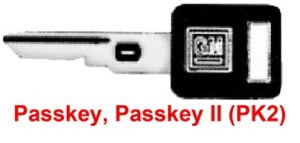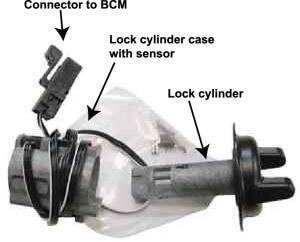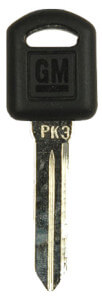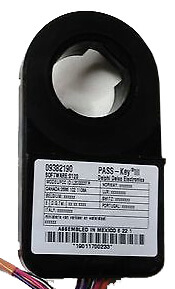PassKey III system
Fix PassKey III system
Car won’t start security light on
If you own a GM vehicle with PassKey iii system or a previous PassKey II or PassLock system and have a car won’t start security light on, this article is for you.
GM’s history of antitheft systems
VATS and PassKey I
GM’s first attempt at vehicle antitheft was called the
See the resistor pellet on the shaft of the key to the left of the plastic.
Vehicle Antitheft System (VATS). It’s really the first PassKey system. Each key has a resistor pellet embedded in the key. When you insert the key, electrical contacts mounted on the lock cylinder read the key’s resistance and that reading is checked to see if it’s the correct key. There are 15 different resistor pellets. The resistance value is read by the Theft Deterrent Module (TDM). In some vehicles the TDM module is part of the instrument cluster. The TDM module determines if you’ve inserted the right key and notifies the PCM with these messages: “Tamper” “Normal” and “Fail Enable”. If the correct key is inserted, the TDM module enables ground to the start enable relay. The relay sends power to the “S” terminal on the starter motor and the PCM enables the fuel injectors.
If the resistance value doesn’t match the programmed value, the TDM module declare a TAMPER mode and enters a time out period for 4-mins. The security light turns on at the same time. The module will not enable the start relay. A bad resistor pellet or dirt on the pellet can cause the system to enter this TAMPER mode. Try cleaning the pellet and restart after the 4-min time out. If the key reading is still incorrect, the system will go into FAIL ENABLE mode allowing you to drive the vehicle, but the SECURITY light will stay on.
In later vehicles the VATS system was renamed to PassKey I. No relearn procedure is required on a VATS or PassKey I system if the PCM is replaced
Fix PassKey II
This system is almost identical to PassKEY I except the TDM is located in the body control module (BCM). The key’s resistance reading is interpreted by the BCM and the BCM sends a message to the PCM telling it the key is valid and it can begin the start sequence. systems relay on a resistor pellet. In later versions called PassKey III, the key includes a transponder in the key. A relearn procedure IS required if the PCM is replaced. See this article for the relearn procedure on PassKey II systems.
PassLockIn later versions GM decided to take the key out of the picture. Instead, they mounted a sensor inside the lock cylinder case.
Lock cylinder and lock cylinder case for PassLock system
As the lock cylinder rotates, a magnet mounted on the cylinder passes the sensor mounted in the lock cylinder case, activating the sensor, which sends a coded signal to the body control module (BCM). There’s a method to GM’s reasoning in changing to this system. First, since there were only 15 possible pellets, thieves could bring resistors with them, and, if they had the time to wait the time-out period they could steal the car by popping the lock cylinder. So GM eliminated the key from the equation. If a thief popped the lock cylinder, it could come out with the magnet and disable the sensor.
PassKey III transponder keys are identified by the PK3 mark on the shank
Unfortunately, the sensor and the wires connecting the sensor to the BCM suffered almost a 100% failure rate.
Fix PassKey III
GM revisits the key system, only this time they located an antenna/transponder in the head of the key. An exciter located at the opening of the lock cylinder activates as the key is inserted. The exciter sends a radio signal that’s received by the transponder. The signal actually energizes the chip in the key head and the key responds by broadcasting a unique identity code that’s received by the Theft Deterrent Exciter Module (TDEM). The TDEM transmits the data to the BCM. The BCM consults its memory and if the identify code matches, it sends a fuel enable code to the PCM. If wrong, the BCM sends a fuel disable code to the PCM. The BCM is also equipped to detect an
The theft deterrent exciter surrounds the lock cylinder entrance and generates an “exciter” signal and then reads the key’s response code
intermittent condition with the transponder. If it loses the code for one second, it sends a fuel disable code to the PCM and the vehicle won’t start. That’s why it’s always best to try a different key if you encounter a car won’t start security light on situation with PassKey III.
What goes wrong with PassKey III systems
The weak link seems to be the theft deterrent exciter module—the unit that surrounds the lock cylinder and “excites” the transponder. This is fairly easy to replace. Simply remove the plastic shround around the steering column and remove and replace the exciter.
The second weak spot that can result in a car won’t start security light on in a PassKey III system is the Theft Deterrent Module
©, 2015 Rick Muscoplat
Posted on by Rick MuscoplatCategories
Tags




